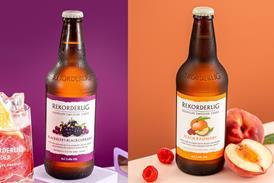The food to go customer mission is seeing major growth, but you need to have a complete meal solution to capitalise on the growing demand
Feeling a little peckish as you flick through the pages of Convenience Store? If so, you’re definitely not alone.
Customers who can’t wait ’til later for something to eat are making food to go the strongest growing convenience shopper mission in the UK, according to HIM Research & Consulting - and one that’s worth £2.2bn in sales to small stores (Kantar Worldpanel).
Statistics show that shoppers are after a meal solution right now, with HIM reporting that 70% of purchasing decisions are made in-store. This means that chilled sandwiches and snacks are often the first port of call for customers looking for some lunch-shaped inspiration.
Samantha Coldbeck from Wharfedale Premier in Hull says that shoppers are no longer treating her c-store as a place to get bits and bobs to complement their lunch - they want to come in and shop the entire meal straight away.
“What I think that people are after today is the whole meal solution,” she says. “They want their crisps, their cup of decent coffee and their sandwiches all together in one place. And we definitely let them know that they can get all of it direct from us every day.”
In her store, customers can choose from a selection of sarnies made in-house with bread from local suppliers, or a range of Booker sandwiches which retail at about the £1 mark.
Whatever they go for, the need for a lunch solution sharpish, and the desire to get good value for money, mean that meal deals are a big hit in the store.
“People do really like the meal deals,” says Samantha. “We do things like a sandwich, a coffee and a flapjack for £4. The customer saves about 70p and they go out feeling really happy with that.”
HIM research director Blake Gladman says that the classic three-component meal deal is right at the heart of the convenience sector’s food-to-go offer.
“Meal deals are perhaps not that common among the up-and-coming grab-and-go outlets such as Prêt à Manger, Leon or Eat,” he explains.
“They certainly can’t compete with the price points that many convenience stores can achieve.”
Brand power
Interestingly, Gladman says that while quality across the deal is all-important, the big attraction for c-store customers might not be the pasty or sarnie at the deal’s core, but the branded confectionery or big-name drink that goes with it.
“The main meal component (the sandwich or equivalent) is not necessarily the main draw,” he says.
“If a store can offer a wide choice of branded snacks/confectionery and drink within the meal deal then the quality of the main component is not necessarily a deal breaker.
“Brands therefore play a big role in driving the success of a meal deal within convenience in my opinion. For a lot of shoppers trust is important in food to go - and this is why we see brands succeeding.”
John Want, head of marketing at Adelie Foods which owns the Urban Eat sandwich brand, concurs. “Convenience stores are seriously underperforming in sandwiches,” he says. “The overall share in grocery is 21%, but convenience stores only sell 9% of total sandwiches.”
He states that part of the problem is that some retailers are tempted to stock unbranded products, simply because they boast a low price. “The quality in some sandwiches priced at 99p isn’t at the same standard as the Walkers crisps and branded bars they sit alongside,” he says. “Big brands provide trust.”
Want claims that a low price is not the sole driver for food to go. “HIM tells us that consumers in convenience are concerned about price, but are equally attracted by brand and quality, and when you look at food to go, it’s more about value for money - ‘a fair price for a good quality product that I recognise’.”
He advises retailers to stock a selection of top sellers, such as Urban Eat’s Legends range, which comprises the top 10 selling sandwich combos in the UK.
Meanwhile, although branded goods are always in stock at Laurie McKinnon’s Spar store in Ilminster, Somerset, the local angle is what really draws customers in looking for lunch.
“As a ballpark figure I’d say we do about 200 sandwiches every day - so it’s a big deal for us,” he says.
Laurie gets sandwiches and subs from three suppliers: Spar, Ginsters and Bonner’s, the local deli and butcher just down the road.
“People really love the local angle,” he says.
“They know the food is fresh and it hasn’t come very far. They can trust what’s in the products, too - which is really important when you’re dealing with something like meat.
“We sell fillings from right across the range, from deli-style coronation chicken to brie and grape using local cheeses,” he adds.
Close relations
Choosing to do business with local suppliers doesn’t just give the store a definable point of difference, it also helps Laurie overcome the sometimes tricky issue of food wastage.
“With Bonner’s, if I’m running out of subs at 2pm I can just give them a call and they’ll be stocked up within the hour because they’re only a mile away,” he says.
Samantha adds that the perceived problem around waste is one of the reasons why c-stores choose to avoid going big with chilled.
“To be honest, it’s a leap of faith when you decide to make the most of the chiller,” she says.
“I think that everyone is worried about the wastage - but it is possible to manage. You have to educate staff to be looking at sales and stock levels and managing things as they go along. It does involve some management, but we’ve really seen how it can be a growth area, too.”
Food to go has been a growth area in the convenience store category for some time now. But as the post-recession retail landscape continues to shift and evolve, and as more players enter the sector retailers are realising they have to continually up their game.
“We’ve actually seen a bit of a levelling out of the food-to-go mission through our latest convenience research this year,” says Gladman.
“I think in part this is down to the expansion of the main competitors in the grab-and-go space, such as Greggs, Prêt à Manger and Costa. Realistically, these are the sort of outlets that traditional convenience stores are competing with when they move into the foodservice space.”
So the new retail reality means that c-stores are up against the supermarkets on one side, and the food-to-go giants on the other. It’s a shift that Samantha accepts - and she’s definitely ready for the challenge.
“What’s happening with food to go in general is like what’s happened to coffee,” she says.
“A few years ago I never would have dreamed that so many people would come in to buy coffee - and they want good coffee, too. Today whatever you’re serving in the store has to be really fresh and of really high quality.
“You’re not just competing with the store down the road, to customers who want food to go - you’re also up against your local Greggs.”
Pasties and pies aim for a bigger slice
While high-end baguettes and artisan crisps may be a winner with many consumers, there’ll always be a place in the chiller for a tasty pasty or pork pie.
“Consumers are always looking for variety and want a change from the traditional ‘sandwich and crisp’ style lunch, so Pork Farms is focused on offering substantial equivalents for the lunchtime occasion, such as big hit sausage rolls, savoury slices, scotch eggs and pork pies,” says Kim Burgess, head of markets at Pork Farms. “Variety is key - gone are the days of just offering sandwiches.”
In this category quality has sometimes been perceived as an issue, which is why the leading brands are set on signposting their provenance. Says Ginsters head of corporate and trade communications Jo Hartop: “Quality food, made using responsibly-sourced ingredients, is more important to consumers than ever, and Ginsters offers this through their best of British ingredients and local sourcing.
“Products which are convenient and easy to eat on the go will also drive sales.”
More than just lunch
The days when office workers would all flee their desks for an hour at one o’ clock and be back by two are long gone. And as meal times become more fluid, c-store retailers find themselves selling sandwiches and snacks right around the clock, from morning to night.
One of these is Laurie McKinnon at Spar in Ilminster, Somerset.
“Sandwiches and snacks are not just for lunch anymore,” points out Laurie.
“We sell sandwiches all through the day. People come in to grab one for their supper, or at the end of their shift for the next day.”
This constant demand for chilled means that simply re-positioning the chiller can help boost sales, too.
“Store manager Mr Jagtar [from the Day-Today store in Saltcoats] noticed that customers like popping in to grab food to eat on-the-go,” says John Kinney, retail director at Today’s Group.
“He tripled the size of the chiller cabinet in order to offer them a wider range of products and positioned the chiller right by the entrance of the store to attract customers as they walked past.”
Bread and butter buys
“While bagels and wraps have shown growth in recent years they are quite niche ‘carriers’,” says Simon Clifford, head of marketing at Country Choice.
He believes the bulk of the market still lies in baguettes, rolls and standard bread, but “there is still a trend towards granary/seeded varieties”.
Similarly with fillings, he says core varieties are chicken (about a third of all fillings), followed by cheese, egg, tuna and ham.
He adds: “There are lots of recipe variations but essentially they all revolve around these core proteins. The number one attribute [for sandwiches] is freshness, followed by variety. After that consumers usually talk about buying from a store that they are familiar with.”
In Brief
Cathedral City in snack packs
Cathedral City Mature Snack Packs are a canny way to satisfy customers’ cheese craving with a slice of big brand action. Each pack delivers 46% of RDA for calcium, which helps maintain strong bones.
Some like it hot with Rustlers
Designed to draw in younger customers who want something hot to nosh right now, Rustlers Super Six range offers a host of heatable meal solutions. Choices include the Quarter Pounder and the Hot Subs Fried Chicken, which brings a Subway-style experience in-store.
Ginsters’ meaty line-up
Leading pie purveyor Ginsters aims to take a bite out of the £108m meat snacking category with its Meat Club selection. Shoppers can choose from flavours such as BBQ and Tandoori served up as either chicken chunks or tasty skewers.
Limited edition flavours from Urban Eat
Retailers can spice up their sandwich offerings with limited edition variants, advises Urban Eat. “If you have space for two or three extra lines, then add interest with limited edition lines or by rotating flavours,” says head of marketing John Want. The firm’s current monthly special is smokin BLT on wholemeal bread.





![PLAUK0125 Jacobs The Trussell Trust Portrait[53]](https://d2dyh47stel7w4.cloudfront.net/Pictures/274x183/6/4/1/322641_plauk0125jacobsthetrusselltrustportrait53_125111_crop.jpg)















No comments yet